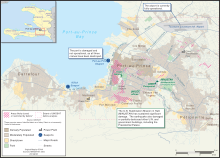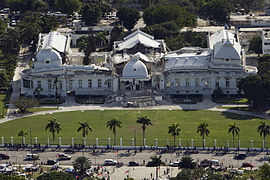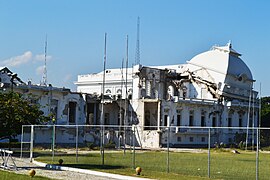| Haitian National Palace | |
|---|---|
| Palais National Haïtien Palè Nasyonal Ayisyen | |
 The National Palace of Haiti in 2006, four years prior to its collapse The National Palace of Haiti in 2006, four years prior to its collapse | |
| Former names | Imperial Palace |
| General information | |
| Status | Destroyed |
| Type | Executive |
| Architectural style | Victorian |
| Location | Champs-de-Mars |
| Address | 6110 Avenue de la Republique |
| Town or city | Port-au-Prince |
| Country | Haiti |
| Coordinates | 18°32′35.2″N 072°20′19.9″W / 18.543111°N 72.338861°W / 18.543111; -72.338861 |
| Construction started | May 1914 |
| Completed | January 1920 |
| Destroyed | January 12, 2010; 15 years ago (2010-01-12) |
| Cost | $350,000 |
| Design and construction | |
| Architect(s) | Georges H. Baussan |

The National Palace (French: Palais National; Haitian Creole: Palè nasyonal) was the official residence of the president of Haiti, located in the capital Port-au-Prince, facing Place L'Ouverture near the Champs de Mars. It was severely damaged during the 2010 Haiti earthquake. The ruins of the building were demolished in 2012 under the Martelly administration, and plans to rebuild the palace were announced by then-president Jovenel Moïse in 2017, but it is unclear if or when reconstruction will begin.
History
Background


A reported total of four residences built for the country's rulers, whether the colonial governor general, king, emperor, or president, have occupied the site since the mid to late 18th century. At one point in the site's tumultuous history, when the chief of state was without an official home due to damage, a 19th-century French-style villa on Avenue Christophe assumed that role.
The earliest structure was the Government Palace (Palais du Gouvernement), which was constructed in the 18th century as the residence of the French governor general of Saint-Domingue. Its first Haitian inhabitant was the country's first president of Haiti, General Alexandre Pétion. The structure was deemed "nothing less than a palace", made of painted wood, with "a handsome flight of steps leading into good reception-rooms". A visitor in 1831 noted the building was "large and convenient, but not handsome. It is of one story, and situated in front of the parade, to the southeast of the town. Its entrance is up a fine flight of steps, leading through a spacious portico into the hall of audience. The floors of all the public rooms are of black and white marble. The furniture is tasteful and elegant, but not costly. This building ... was constructed with more attention to convenience than effect. The apartments are pleasantly cool." In front of the palace stood the marble tomb of President Pétion and one of his daughters.
By 1850, the former governor general's residence had become known as the Imperial Palace, since it was the residence of Emperor Faustin I of Haiti and his wife, Empress Adélina. John Bigelow, an editor at the New York Evening Post, visited the palace in 1850 and described it as "only one story, raised a few feet from the ground, and approached by four or five steps, which extend all around the edifice." He also noted aspects of the interior decoration: "The floor is white marble, the furniture in black hair-cloth and straw. On a richly carved table appeared a beautiful bronze clock, representing the arms of Haiti—namely, a palm-tree surrounded with fascines of pikes and surmounted with the Phrygian cap. The walls were decorated with two fine portraits ... One represents the celebrated French conventionist, the Abbé Grégoire, and the other the reigning Emperor of Haiti .... The latter does honor to the talent of a mulatto artist, the Baron Colbert." An adjoining salon, where "grand receptions are given," displayed "portraits of all the great men of Haiti".
The former Imperial Palace was destroyed on 19 December 1869 during a revolt that brought down the government of President Sylvain Salnave. The building was bombarded during the conflict by the man-of-war La Terreur, a government warship that had been captured by the rebel forces. As a contemporary report stated, "It appeared that Salnave had stowed away in vaults at the Palace a large quantity of ammunition. The shells fired from the Terreur, penetrating these vaults, caused several terrific explosions, and the palace was wholly destroyed". Salnave succeeded in reaching the Dominican territory. On January 15, 1870, Salnave arrived at Port-au-Prince, where he appeared before a court martial. He was sentenced to death and shot on the same day.
The palace's replacement was built in 1881. National Geographic called the palace "a rather ugly structure of glistening gray white, with apparently a good deal of corrugated iron about it," though adding that it "contained, however, some fine lofty rooms". Others called it "a low straggling house" whose rooms were "pretty and decorated à la française". The replacement palace was seriously damaged on 8 August 1912 by a violent explosion that killed President Cincinnatus Leconte and several hundred of his soldiers almost a year to the day from Leconte's election. "The President had been unable to trust anyone with the keeping of the national supply of ammunition and was forced to keep it in his own palace", and died as a result.
Design

The National Palace most recently occupying the site was designed in 1912 by Georges Baussan (1874–1958), a leading Haitian architect who graduated from the Ecole d'Architecture in Paris and whose commissions included the City Hall of Port-au-Prince and Haiti's Supreme Court Building. He was a son of a former Haitian senator and the father of Robert Baussan, an architect who studied under Le Corbusier and later became the country's Undersecretary of State for Tourism. Baussan's classical design was chosen from a range of plans submitted by Haitian and French architects in a national competition in 1912. His entry was awarded the second-place prize but also was selected to be the new National Palace, for financial reasons—the structure proposed by the first-place winner was deemed too costly. The construction budget for the new palace was set at $350,000 and work began in May 1914. By 1915, however, the under-construction palace was set ablaze by a mob that ousted and assassinated President Vilbrun Guillaume Sam. A contemporary news report stated the palace "has been partially destroyed after an early-morning attack which lasted several hours". After President Sam's death, the country was occupied by the United States, with U.S. forces taking possession of the palace and U.S. naval engineers overseeing its completion. The building was finished in 1920.

John Dryden Kuser, a wealthy American who visited Haiti in January 1920, described the new National Palace as "a huge structure, quite like a palace in appearance .... It is more than twice the size of our White House and is shaped like the letter E, with the three wings running back from the front. In the main hall huge columns rise to the ceiling and at each side a staircase winds up to the second floor". The primary rooms, Kuser noted, including the office of the president, were all about 40 feet square.
Like other public buildings in Haiti, Baussan's National Palace drew on the tradition of French Renaissance architecture and greatly resembled structures erected in France and its colonial territories during the late 19th century, such as the Saigon Governor's Palace, the residence of the French governor general of Cochinchina. Made of white-painted reinforced concrete, the two-story National Palace had a central section featuring a domed entrance pavilion whose four Ionic columns supported a pedimented portico; at either end of the main façade were matching domed pavilions, also groined. The presidents and their families lived in the south wing of the building.
Earthquake damage
Main article: 2010 Haiti earthquake § General infrastructureOn January 12, 2010, the National Palace was severely damaged by a magnitude 7.0 earthquake centered about 16 kilometres (10 mi) away from Port-au-Prince. The collapsed cupola has become a symbol of the devastated quake-hit nation. The second floor of the building collapsed almost completely, taking the attic floor with it; the palace's columned central pavilion, a section containing the main hall and primary staircase, was entirely demolished. At the time of the earthquake, President René Préval and his wife, Elisabeth Delatour Préval, were at their private residence in another part of Port-au-Prince.
France offered to rebuild the presidential palace, but in April 2010, the Haitian government announced plans to demolish the palace in preparation for reconstruction. Demolition and clearance of the site took place between September and December 2012.
-
 The National Palace after the 2010 Haiti earthquake
The National Palace after the 2010 Haiti earthquake
-
 Closeup of the National Palace in ruins, in 2012
Closeup of the National Palace in ruins, in 2012
-
 The National Palace being demolished in late 2012
The National Palace being demolished in late 2012
Temporary residence
President Moïse's personal residence on Pelerin 5 south of Pétion-Ville was used as the de facto presidential palace, but he relocated to another home in the Juventas area.
Reconstruction
A little more than two months after taking the presidency, President Jovenel Moïse announced on April 19, 2017, that they will be commencing the rehabilitation of the National Palace. He presented a committee of engineers and architects who will analyze the project as well as its construction. Moïse stated that the palace's exterior will look the same, but the interior will be modernized to fit the needs of a head of state in the coming years and the building must be earthquake-proof.
See also
References
- ^ Lacey, Marc (January 22, 2010). "Haiti's Icon of Power, Now Palace for Ghosts". New York Times. Retrieved January 23, 2010.
- "Hundreds feared dead in Haiti earthquake". Sydney Morning Herald. January 13, 2010. Retrieved January 13, 2010.
- The New World Guides to the Latin American Republics, Volume 1 (Duell, Sloan and Pearce, 1950), page 22
- Bojarski, Sam (January 10, 2020). "National Palace Rebuilding Effort in Limbo 10 Years After Earthquake". Haitian Times. Retrieved February 8, 2024.
- ARCHIBOLD, Rndal (September 13, 2012). "Haiti's Quake-Damaged National Palace Being Demolished". The New York Times. Retrieved September 13, 2012.
- "An Island Luminous". Florida International University. Retrieved March 6, 2021.
- "This Day in History: Haitian National Palace explodes". caribbean National Weekly. August 8, 2016. Retrieved March 6, 2021.
- ^ John Dryden Kuser, Haiti: Its Dawn of Progress After Years In a Night of Revolution (Richard G. Badger/The Gorham Press, 1921), page 16
- The American Monthly Magazine and Critical Review, 1818, Volume 3, page 149
- David S. Shields and Mariselle Meléndez, Liberty! Égalité! Independencia!: print culture, Enlightenment, and revolution in the Americas, 1776-1838 : papers from a conference at the American Antiquarian Society in June 2006 (American Antiquarian Society, 2007), page 113
- "Recent communications from a Traveller in Hayti", The Friend, Volume 4 (The Friend., 1831), page 266
- "A handsome flight" cited in Charles Mackenzie, Notes on Haiti: made during a residence in that republic, Volume 1 (H. Colburn and R. Bentley, 1830), pages 3-4
- "Nothing less than a palace" cited in Charles W. Mossell and Thomas Prosper Gragnon-Lacoste, Toussaint L'Ouverture, the hero of Saint Domingo, soldier, statesman, martyr: or, Hayti's struggle, triumph, independence, and achievements (Ward and Cobb, 1896), page 165
- "Hayti: Population, Government, Manners and Customs, Commerce, &c &c.", The New York Times, 14 July 1852
- John Bigelow, Jamaica in 1850, or, The Effects of Sixteen Years of Freedom On a Slave Colony (G. P. Putman, 1851), pages 189-192
- "Hayti: Particulars of the Capture of Port-au-Prince—Shelling and Total Destruction of the Palace—The Arsenal and Barracks Blown Up—Salnave Desperate—Provisional President Saget in the City—Salnave Not Yet Captured", The New York Times, 5 January 1870
- "Hayti: Intelligence Direct from Port-au-Prince: The Details of the Downfall of Salnave", The New York Times, 22 January 1870
- ^ Edward, Crain (1994). Historic architecture in the Caribbean Islands. University Press of Florida. p. 174. ISBN 978-0-8130-1293-3.
- Léger, Jacques Nicolas (1907). Haiti, Her History and Her Detractors. Neale Publishing Company. pp. 211–216.
 This article incorporates text from this source, which is in the public domain.
This article incorporates text from this source, which is in the public domain.
- Harry Johnston (1920). "Haiti: The Home of Twin Republics". National Geographic Magazine. 38. USA: 496. hdl:2027/njp.32101077278131.
- "low straggling house" from "An Impression of Haiti", The New York Times, 29 April 1900
- "pretty and decorated à la française" from "Gherardi and Hippolyte: The Admiral's State Reception at Port au Prince ", The New York Times, 29 December 1889
- Plummer, Brenda Gayle (October 1981). "Race, Nationality, and Trade in the Caribbean: The Syrians in Haiti, 1903–1934". The International History Review. 3 (4): 517–539. doi:10.1080/07075332.1981.9640260.
- ^ Danner, Mark (August 11, 1991). "To Haiti, With Love and Squalor". The New York Times. Retrieved January 13, 2010.
- "Explosion Kills Haitian President", The New York Times, 9 August 1912
- ^ Ruth Danenhower Wilson, Here is Haiti (Philosophical Library, 1957), page 47
- Seabrook, B. (1929). The Magic Island. New York, New York: Harcourt, Brace. p. 134.
- Craig Claiborne, "Haitian Hideaway", The New York Times, 19 June 1960
- The younger son of Georges H. Baussan, Robert Baussan (born 1908) also owned the luxury Ibo Lelé Hotel in Petion-Ville, a mountain suburb of Port-au-Prince; it had originally been designed as a villa for him and his family. Among his many projects was Cabane Chouchoune, a thatch-roof nightclub whose circular form and materials echoed African tribal architecture. His wife, Tamara Baussan (née Tamara Zekom, 1909–1999), was a Russian émigré who became a leading Haitian painter and sculptor. Their children, Jacques Baussan and Michèle Baussan Chassagne, managed another Baussan family property, Ibo Beach, a cottage colony on Cacique Island in Port-au-Prince harbor.
- Bulletin of the Pan-American Union, Volume 37 (The Union, 1913), page 616
- Haïti, 1919–1920: Livre bleu d'Haïti (Compagnie biographique, 1920), pages 80–81
- Robert Debs Heinl and Nancy Gordon Heinl, Written in Blood: The Story of the Haitian People, 1492–1971 (Houghton Mifflin, 1978), page 371
- The builder assigned the task was Simmonds Frères. The government funded the construction of the building through a tax on "the exportation of cocoa and other products", according to "Haiti", The Bulletin of the Pan-American Union, 1914, Volume 43, page 163
- "Haitian Massacre; President Flees; Zamor Executed", The New York Times, 28 July 1915
- Haïti à la une: une anthologie a la presse haïtienne de 1724 à 1934, Volume 1 (1997), page 174
- Richard Eder, "Haiti: Land of the 'Big Tontons'", The New York Times, 24 January 1965
- "Americans Again Fire on Haitians", The New York Times, 7 August 1915
- John Dryden Kuser, Haiti: Its Dawn of Progress After Years In a Night of Revolution (Richard G. Badger/The Gorham Press, 1921), page 16. Kuser was a son-in-law of John H. Russell, Jr., the Marine Corps general who served as American High Commissioner in Haiti (1922-1930) during the U. S. occupation. He visited Haiti in January 1920 and described the National Palace as "at a stage of near-completion, with one wing already occupied ..."
- John Dryden Kuser, Haiti: Its Dawn of Progress After Years In a Night of Revolution (Richard G. Badger/The Gorham Press, 1921), page 73-74
- Edward E. Crain, Historic Architecture in the Caribbean Islands (University Press of Florida, 1994), page 174
- Haiti Architecture architecture.about.com
- "Ciment armé" (reinforced concrete) cited in Haïti, 1919-1920: Livre Bleu d'Haïti (The Klebold Press, 1920), page 62
- Selden Rodman, Haiti: The Black Republic (Devin-Adair, 1973), page 112
- "Thousands feared dead as huge earthquake destroys Haiti presidential palace". The Times. January 13, 2010. Archived from the original on June 4, 2011. Retrieved January 13, 2010.
- ^ "France to rebuild Haiti's presidential palace". Channel News Asia. MediaCorp Pte. January 28, 2010. Retrieved February 23, 2010.
- "Haiti Manifestation : Big conflict in Pelerin 5 where President Jovenel Moise lives".
- "Haiti to rebuild quake-damaged National Palace". BBC News. April 19, 2017. Retrieved July 20, 2017.
External links
Categories:- Buildings and structures in Port-au-Prince
- Buildings and structures demolished in 2012
- Government buildings in Haiti
- Houses completed in 1920
- Palaces in Haiti
- Presidential residences
- Renaissance Revival architecture
- 2010 disestablishments in Haiti
- 1920 establishments in Haiti
- Victorian architecture in North America